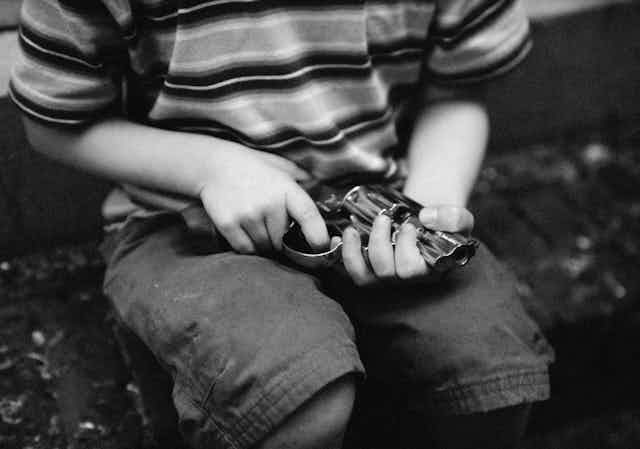For the past few years, guns have been identified as the leading cause of death for children in the United States.
There were 2,571 children age 1 to 17 who died in shootings in the U.S. in 2021, 68% more than the 1,531 that occurred in 2000.
To help reduce the number of firearm-related deaths and injuries among children, Secretary of Education Miguel Cardona in January 2024 called upon school and district administrators to talk with parents and guardians about safe firearm storage practices.
As experts on the safe storage of firearms – and as leaders of the University of Connecticut’s ARMS Center for Gun Injury Prevention – we often get questions about the best ways to keep guns out of the hands of children. We offer the following tips:
1. Safely store all of your firearms
Nearly half of the households in the U.S. have at least one firearm, but only about 40% of firearm owners store all of their guns when not in use, according to data in a survey we recently fielded. Unsecured firearms have been linked to suicides, domestic homicides and accidental shootings. They also heighten the risk of unauthorized use, which includes theft.
2. Don’t assume you can hide your guns

Kids generally know the hiding spots for the things their parents or caretakers do not want them to find, such as holiday gifts or Halloween candy. The same is true with firearms.
In 40% of gun-owning households with children, adults said their children did not know where firearms were stored, a 2017 study found. However, many of the children reported knowing and being able to access the firearms.
Researchers estimate that 75% of children who live in homes with guns know where they are stored.
Adults may think they can instruct children to leave firearms alone, but the 2017 study also found that 22% of parents wrongly believed that their children had never handled their gun.
3. Store ammunition separately
Research shows that locking ammunition separately from firearms further reduces the risk of firearm injuries in homes with children and teenagers.

While storing an unreadied weapon locked away may feel counterintuitive to those who own guns for personal protection, research shows that keeping firearms locked or unloaded, or both, can also reduce risk of injury.
4. Learn to talk about firearm safety
While some families may not have firearms in their home, eventually children go to other homes and, as they get older, go unsupervised.
Keeping children safe from gun violence requires normalizing conversations on firearm storage, even for people in households where no gun is present.
Approximately 45% of all unintentional shooting deaths of children under 17 occurred outside of their own homes. When children visit friends, we believe it’s important for their parents to know if guns are present in the home they are visiting and, if present, whether those firearms are being safely stored.
For more information about how to discuss firearm safety, parents can visit websites such as BeSMART, End Family Fire and Secure Storage of Lethal Means.
5. Know the law
Twenty-seven states have some version of secure storage laws.
Based on our calculations using data from the Centers for Disease Control and Prevention, states with child access prevention laws – known as CAP laws – have a gun death rate that is 65% lower than states that do not have CAP laws (12.33 vs. 20.38 per 100,000). Of course, states with and without CAP laws have many differences; therefore, the lower rates cannot be attributed to CAP laws alone. However, the presence of CAP laws is protective and reduces gun death.
In the absence of a federal secure storage law, the legal requirements around firearm storage and preventing unauthorized children from accessing weapons vary by state or municipality.
For example, Connecticut requires firearms be in a locked device when not in use.
Iowa prohibits the storing or leaving a loaded firearm around children 14 and younger if it is not secured by a trigger lock or a securely locked container or some other secure location.
Further, while Michigan only recently added a safe storage law, Jennifer Crumbley, the mother of a boy who committed a mass school shooting with his parents’ unsecured firearm, was recently convicted of involuntary manslaughter in connection with the case. Her husband’s trial in the matter began on March 5, 2024.
6. Invest in a quality safe and/or locking device
There are various levels of locked gun storage, including trigger locks, metal cable locks, locked gun cases and gun safes. While storing a firearm and the ammunition in a locked combination or biometric device is safest, all of these methods can reduce the risk of gun injury and death. These locking devices can be purchased online, through some gun sellers or at sporting goods stores.

A biometric safe for a handgun is about US$65, a gun lock runs $55 to $75 dollars, and combination safes for long guns range widely from a couple of hundred dollars to a few thousand dollars.
Family-school-community partnerships allow America’s children to grow and thrive. By asking schools to share resources for secure firearm storage and communicate evidence-based safety practices, the Department of Education is helping schools address the leading cause of death among American children.
But families have to do their part, too. It begins by normalizing firearm safety conversations and storing firearms properly to keep children safe.

